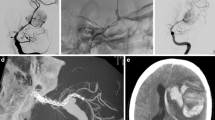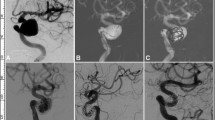Abstract
The twisting phenomenon of the flow diverter stents rarely occurs, but it recently became relatively well-recognized. There have been few reports on single-layer flow diverters only. The Flow Redirection Endoluminal Device (FRED) (MicroVention, Tustin, California) has a unique design characterized by a braided dual-layer self-expanding stent. There have been no reports on the twisting phenomenon of FRED. This study reports two cases of acute in-stent blood flow disturbances after the deployment of FRED in a patient with intracranial aneurysms associated with “ghost twisting.” In this phenomenon, the inner layer does not expand with the coning deformation, even though the outer layer is fully open. This was confirmed through high-resolution cone-beam computed tomography, but not conventional angiography. The two cases were successfully treated using balloon angioplasty and showed favorable outcomes. The structural issue of “ghost twisting” was a possible underlying factor for the ischemic complications associated with FRED deployment.


Similar content being viewed by others
References
Möhlenbruch MA, Herweh C, Jestaedt L, Stampfl S, Schönenberger S, Ringleb PA, Bendszus M, Pham M (2015) The FRED flow-diverter stent for intracranial aneurysms: clinical study to assess safety and efficacy. AJNR Am J Neuroradiol 36(6):1155–1161. https://doi.org/10.3174/ajnr.A4251
Young RW, Bender MT, Colby GP, Coon AL (2019) Multiple pipeline twists encountered during treatment of a symptomatic fusiform ICA aneurysm. BMJ Case Rep 12(7):e230036. https://doi.org/10.1136/bcr-2019-230036
Bender MT, Young RW, Zarrin DA, Campos JK, Caplan JM, Huang J, Tamargo RJ, Lin LM, Colby GP, Coon AL (2020) Twisting: incidence and risk factors of an intraprocedural challenge associated with pipeline flow diversion of cerebral aneurysms. Neurosurgery 88(1):25–35. https://doi.org/10.1093/neuros/nyaa309
Shapiro M. Torsion; pipeline flex. neuroangio.org. Accessed April 4, 2023. http://neuroangio.org/pipeline-device/pipeline_flex/#Torsion
Pierot L, Spelle L, Berge J, Januel AC, Herbreteau D, Aggour M, Piotin M, Biondi A, Barreau X, Mounayer C, Papagiannaki C, Lejeune JP, Gauvrit JY, Derelle AL, Chabert E, Costalat V (2019) SAFE study (Safety and efficacy Analysis of FRED Embolic device in aneurysm treatment): 1-year clinical and anatomical results. J Neurointerv Surg 11(2):184–189. https://doi.org/10.1136/neurintsurg-2018-014261
Suyama K, Nakahara I, Matsumoto S, Suyama Y, Morioka J, Hasebe A, Tanabe J, Watanabe S, Kuwahara K (2022) Efficacy of the flow re-direction endoluminal device for cerebral aneurysms and causes of failed deployment. Neuroradiology 64(6):1213–1219. https://doi.org/10.1007/s00234-021-02858-w
Khorasanizadeh M, Shutran M, Schirmer CM, Salem MM, Ringer AJ, Grandhi R, Mitha AP, Levitt MR, Jankowitz BT, Taussky P, Thomas AJ, Moore JM, Ogilvy CS (2022) North American multicenter experience with the flow redirection endoluminal device in the treatment of intracranial aneurysms. J Neurosurg 1–11. https://doi.org/10.3171/2022.7.Jns221371
Author information
Authors and Affiliations
Corresponding author
Ethics declarations
Conflict of interest
The author declares no competing interests.
Ethical approval
This study protocol was reviewed and approved by the ethics committee of Tokyo Medical and Dental University (M2020-102).
Consent to participate
Informed consent was obtained from all individual participants included in the study.
Consent for publication
The participants have consented to the submission of the case report to the journal.
Additional information
Publisher's note
Springer Nature remains neutral with regard to jurisdictional claims in published maps and institutional affiliations.
Rights and permissions
Springer Nature or its licensor (e.g. a society or other partner) holds exclusive rights to this article under a publishing agreement with the author(s) or other rightsholder(s); author self-archiving of the accepted manuscript version of this article is solely governed by the terms of such publishing agreement and applicable law.
About this article
Cite this article
Hirai, S., Ishikawa, M., Sagawa, H. et al. Ghost twisting of the dual-layer flow-diverting stent. Neuroradiology 65, 1669–1672 (2023). https://doi.org/10.1007/s00234-023-03215-9
Received:
Accepted:
Published:
Issue Date:
DOI: https://doi.org/10.1007/s00234-023-03215-9




